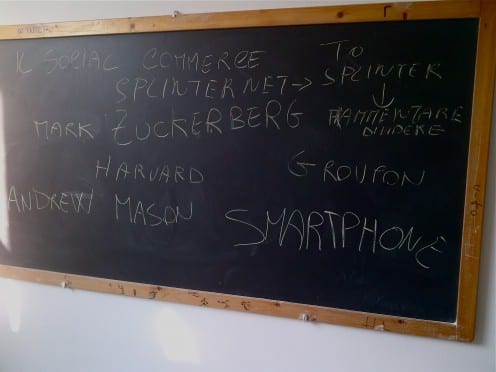The normativity of social media
By Razvan Nicolescu, on 26 December 2013

Blackboard after a class of communication in one of the local High Schools. Photographed by Razvan Nicolescu.
The questionnaires we applied this summer in our Italian fieldsite showed that around 40% of respondents who were on Facebook had never changed their privacy settings, which means their profiles were public. At the same time, more than 80% responded they were not concerned or did not care if an individual or an organization would use their personal data available on the platform. These percentages were much higher than I expected, and seemed relatively high when compared to similar data collected from other fieldsites in the project. They suggested that in general Italians are quite relaxed about their online appearance as well as about the content they post or produce online. Further investigation into the usage of social media suggested that Italians’ online presence is characterized by a strong sense of normativity. This sense seems to be the result of the juxtaposition of two different forces: on the one hand there is a strong sense that society is characterized by a particular order and predictability that should not be contradicted, not even online. This is expressed, for example, through a high concern on what one should post, how one should behave, what one should ‘Like,’ and so on. The second force is expressed through a high concern about the performative (in Goffman‘s terms). This is again normative, as most individuals try to present themselves online the way they think society is expecting them to. In other words, there is a great consistency between the way people present themselves online and what they think society thinks about them. For example, with the notable exception of teenagers, the very few histrionic or ‘inconsistent’ online profiles belong to highly educated people who also have some sort of privileged access to different forms of cultural capital. At the same time, people use other media, such as mobile phones, including mobile phone Apps, Skype, or photography, for their most private issues. This seems to be related to the fact that these media are used to communicate in more private spaces, in smaller groups, or in one-to-one fashion .However, most of the content of this relatively private communication will be made public sooner or later, including via social media. It seems that most of the time the information that is considered sensitive goes through a series of more private filters until it can be safely displayed in such an accessible space as, say, Facebook. Therefore, the information is normally displayed on Facebook after losing a few layers: it could lose much of its novelty, it could lose or disguise most of its private character, some of its specificity, and so on. At the same time, the loss in novelty could be compensated through actions of close friends such as ‘Likes’ or a lively series of comments. The loss of privacy could be balanced out by a gain in audience, and the loss in specificity could be offset by the personal creativity and the capacity to relate to other issues that are more public and popular for a certain audience.
People I work with continue to tell me in different ways how online they constantly dress and undress information following this pattern. Usually, they aim to find a way, even if eccentric or innovative, to fit in at least one definition of normativity. This brief discussion suggests a few things. First, social media could help us to understand the bigger social system of which it is a part, if we think of social media as a place where people delegate and work out different parts of their sociality. It is the aggregate of these delegations that we hope will tell something about people and the society in which they live. Much of this ethos is condensed in terms such as Polymedia or Digital Anthropology. This project also aims to identify other common expressions of diversity. Secondly, in the Italian fieldsite it seems that social media works not towards change – of society, notions of individuality and connectedness, and so on – but rather as a conservative force that tends to strengthen the conventional social relations and to reify society as Italians enjoy and recognize it. The normativity of the online presence seems to be just one expression of this process.
 Close
Close




